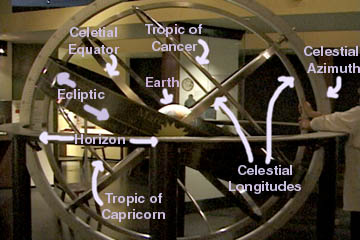How
Armillary Sphere
 To
To
The Parts
|
Earth--represented by the globe in the center of the model. This is our relative perspective and the perspective of the medieval designers, not the astronomical truth. Celestial equator--the circle located above and following the earth's equator which represents the imaginary reflection of the earth's equator in the sky. The ecliptic (see below) crosses the celestial equator on the first day of spring and the first day of fall. Ecliptic--wide flat elliptical band running at an angle to the celestial equator representing the apparent path followed by the sun, moon, planets and zodiac constellations. ("Apparent" path because the earth--and other planets--are moving, not the sun and the stars.) The ecliptic is marked with the dates of the year on the outside, and the constellations of the zodiac on the inside. (Medieval astronomers could use an armillary sphere to determine the time of year or special events in either the day or the night.) Horizon--the large steel band parallel to the floor which represents the viewer's horizon. It is engraved with the degrees of the compass. The horizon is fixed for a viewer at a latitude of 42 degrees, approximately the latitude of Chicago. (See Azimuth, below) Azimuth--the large steel band perpedicular and fixed to the horizon which is engraved to represent the degrees of latitude on earth. Our model is tipped so that the mark for 42 degrees on the azimuth intersects the horizon at the 0 degree (north) mark on the horizon. Celestial longitudes--circle perpendicular to the celestial equator, representing the reflection of the circle representing latitudes 0/180 degrees (Greenwich and the International Date Line) and 90/180 degrees (halfway between Greenwich and the International Date Line in each direction). Celestial Tropic of Cancer--circle located above and following the earthly Tropic of Cancer which represents the reflection of the Tropic of Cancer into the sky. The Tropic of Cancer is located approximately 22.5 degrees north of the Equator and marks the furthest north that the sun can be seen directly overhead (90 degrees above the horizon). The ecliptic crosses the Tropic of Cancer on the first day of summer, in the zodiac sign of Cancer (hence the name). Celestial Tropic of Capricorn-circle located above and following the earthly Tropic of Capricorn which represents the reflection of the Tropic of Capricorn into the sky. The Tropic of Capricorn is located approximately 22.5 degrees north of the Equator and marks the furthest south that the sun can be seen directly overhead (90 degrees above the horizon). The ecliptic crosses the Tropic of Capricorn on the first day of winter, in the zodiac sign of Capricorn (hence the name).
|
How to read the armillary sphere
|
Read the marks of the azimuth where it intersects the band of the horizon at 0 degrees (north) to determine for which degree of latitude the model is set. This information helps currents astronomers determine where one of the historical armillary spheres may have been made or used. Place an image of the sun (or moon or planets) on the ecliptic on the date we want to watch. Rotate the sphere until the sun "rises" and "sets" where the ecliptic crosses the horizon on that day. Read the compass marks engraved on the steel horizon band at that point to find out the compass heading where the sun will rise and set in the sky on that date. (To check the accuracy of the reading, wait until that date, take your compass, go to the Chicago shore of Lake Michigan, and look in the direction that the armillary sphere told you to look. If it's not cloudy, the sun will be there.) As an added exercise, notice where all of the circular bars of the model cross each other. Each crossing of the ecliptic with a celestial longitude and the celestial equator or tropics marks a solstice or an equinox. Although determining the location of sunrises and sunsets is our main demonstration of the armillary sphere, you can also watch how the ecliptic moves north to south and higher and lower in the model to get a sense of how the sun appears to behave throughout the year. Finally, imagine tipping the armillary sphere to a different latitude on the azimuth. You would push the axis of the earth (where it comes out of the north pole) down (and eventually upside down) to move further south and up approzimately 48 degrees to set the model for the north pole. Then try to picture how the ecliptic would act. (It's not easy to imagine, really. Go to Tell Me More for a general description of what happens at different latitudes (since we can't all live in Chicago).
|
Find out where the sun will rise and set on . . .
Watch the sun's path (the ecliptic) move through the year
Back to Armillary Sphere Page
Back to Universe in Your Hands
Back to Adler Planetarium and Astronomy Museum
All images copyright 1999, The Adler Planetarium and Astronomy
Museum.
This page, including all components (writing, graphics, photography
and videography), was designed and executed by Lisa Schuyler Jewell.
Any inquiries about the Adler site should be directed to webmaster@adlerplanetarium.org
